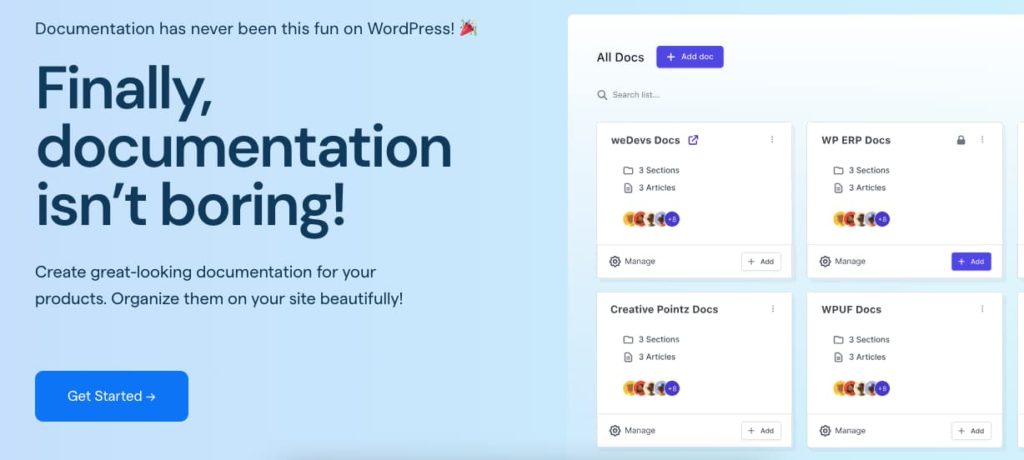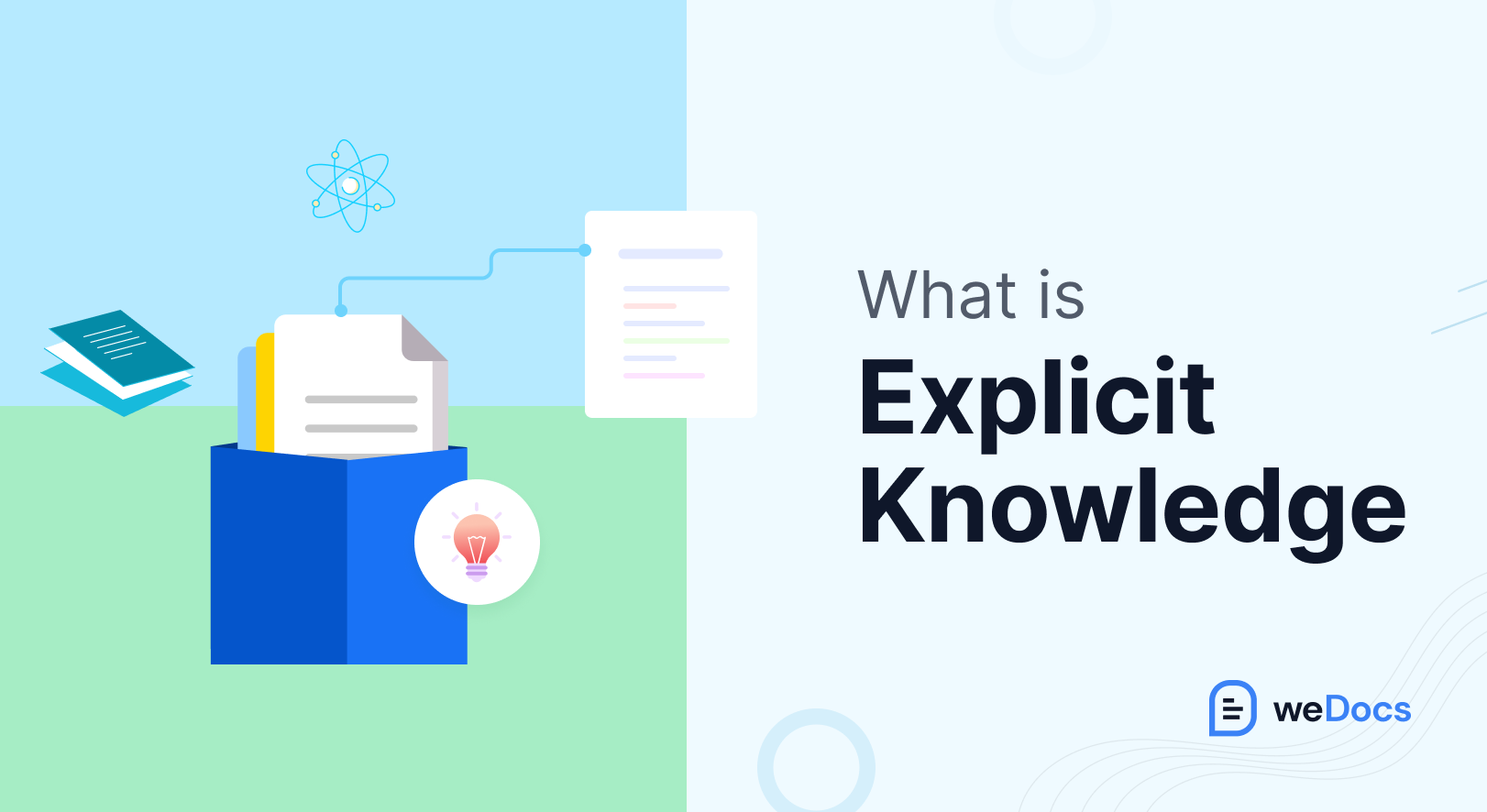Companies have been creating sharable knowledge bases for a long time. One of the earliest user manuals was written by Kodak for their camera users back in 1900.
Since then, the idea of explicit knowledge developed over time. Brands create different types of documents to help customers and for their internal uses.
Through this blog, you will learn what explicit knowledge is with examples, the benefits of creating them for your business, and much more.
What is Explicit Knowledge
Explicit knowledge, or should we call it expressive knowledge, is any info that you can pass on to others.
For example, you can create manuals, textbooks, and even financial reports. And then share them with your colleagues or customers.
Anyone can grab it, look it over, and understand the company’s financial situation. It’s ready for anyone to access and learn from. You can put it in all formats, like databases or good old-fashioned books and videos.
Types of Explicit Knowledge with Examples
There are a lot of examples of explicit knowledge. We’ll talk about some of the common ones here –
1. User Guide
A user guide, also known as a user manual, is a classic example of explicit knowledge. It falls under the category of documentation that instructs users on operating a product, service, or application.
2. Code of Conduct
A Code of Conduct guide outlines the expected behavior within a company, community, or even online platform. You’ll get a clear set of rules and principles into it.
Imagine your company is like a big team working together to achieve a goal. Now, everyone needs to be on the same page, right? To make sure it happens, a code of conduct acts like a team rulebook.
The code of conduct talks about how employees in a company should behave with each other and the customers. You’ll know how to talk to the customers if they ask you a question about who’s responsible for what.
3. Employee Handbook
It’s like a company guidebook! The employee handbook contains useful info about the company, your job, and your rights as an employee. Think of it as a one-stop shop that gets you informational resources.
There can be step-by-step guides to increase productivity, some instructions to improve your focus on work, etc. These guides can even be shared with your department so everyone’s on the same page.
4. Operations Manual
It is almost the same as the user guide. But it’s more detailed. There can be a step-by-step guide to specific instructions. By following the manual, you’ll be less likely to make mistakes and become a pro at your job faster.
5. Standard Operating Procedures (SOPs)
Standard Operating Procedures (SOPs) are like the recipes of the business world! They’ve got detailed instructions on specific tasks inside a company.
What does a recipe do? It ensures everyone makes the same delicious dish. Well, SOPs guarantee that employees complete tasks the same way every time. This leads to consistent results and high-quality work.
Thanks to SOPs, a new employee can learn the ropes faster and avoid common pitfalls.
6. Business Glossary
A business glossary is a centralized reference guide. It defines the important business terms used throughout a company. It’s like a specialized dictionary specifically designed for your organization.
This shared understanding of key terms ensures everyone speaks the same ‘language’ when discussing business operations, data, and goals.
For example, a marketing department might define ‘conversion rate’ as the percentage of website visitors who take a desired action, like making a purchase.
Meanwhile, the finance department might define the ‘cost of goods sold’ as the direct expenses associated with producing the goods a company sells.
By having these definitions documented in a central location, everyone in the company can understand how these terms are used in different contexts. This will allow them to avoid confusion and promote clear communication.
7. Customer Feedback
A centralized customer feedback system is a digital hub that gathers and stores all customer feedback in one place. We’re talking about comments from online surveys, reviews on social media, or even direct emails to the company.
By having a central location for this information, companies can easily access and analyze customer sentiment. For this, they can provide better customer service and product development.
Imagine you run a company selling awesome stuff (or providing amazing services!). Customer service representatives can jump in and see any concerns, like a wonky gadget mentioned in a review. They can then forward it to the right department to fix the problem, keeping the customer happy.
8. Market Research Report
Ever wonder who your ideal customer is? Market research reports are like detective work for businesses. They uncover everything about your customer base.
These reports discuss the latest trends and how people behave. They even check out your competitors, spilling the tea on their marketing moves so you can stay ahead of the game.
These reports aren’t just top-secret files locked away – they’re shared with your sales team and marketing wizards. Armed with this intel, they can craft winning sales strategies and marketing campaigns to reel in new customers and boost that sweet, sweet revenue.
9. Financial Statements
Think of financial statements as a company’s money report card. It tracks everything from what the company owns (assets) to what it owes (liabilities). It even shows how much money the company has left over after everything’s paid (equity) and how much money it’s bringing in (income).
This info isn’t just for accountants! Company leaders use it to make smart decisions about the business, like where to invest their money. Financial statements are also like a financial resume, shared with potential investors to show them how healthy the company is financially.
The cool thing? This information is easy to understand and share with others, making it a prime example of explicit knowledge.
10. Process Documentation
It’s the collection of instructions for all the key things you do in a company, from customer support to marketing and product development. Think of it like a recipe book for work! Everyone can access it to solve problems and get things done smoothly, and there will be no more starting from scratch.
Benefits of Explicit Knowledge

So, you’re wondering why you should bother capturing all this company know-how? Well, there are tons of perks!
Faster and Flinkier
Imagine everyone having the answers they need on hand. This happens with the help of clear instructions and easy-to-find documents. People don’t have to wait for that one person with the answer. This knowledge-sharing makes the whole company move a lot faster. It’s like everyone’s on the same page, saying ‘Hey, we’ve got this!’
Crystal Clear Communication
Writing down all this knowledge helps everyone speak the same language. People can see what others already know, so they don’t waste time bugging colleagues for the same information.
Faster Decision Making
When you have all sorts of knowledge readily available, you can make quicker decisions. No one has to wait for some decision-maker. It’s a fast way to execute.
No Reinventing the Wheel
Documenting past solutions saves everyone time. Instead of starting from scratch, employees can learn from the company’s past successes and build on them.
Fewer Errors
Putting your policies and procedures in writing reduces mistakes. When tackling a task, employees can refer to the documentation and follow the established steps to get it right the first time.
Company Brainiacs
By capturing all this knowledge, you’re creating valuable assets for the company. This knowledge is company brainpower, and it increases your overall worth. Think of it like your company’s secret sauce – protect it well!
Differences Between Explicit Knowledge and Tacit Knowledge

The key differences between Explicit knowledge and Tacit knowledge are discussed here.
Explicit knowledge is all about the “know-what.” It’s something you can just write down easily, share, and learn from a textbook. The knowledge is more about ‘theories’ than experience. Think of it as the recipe itself. It lists the ingredients, the steps, and maybe even some baking temperatures.
This kind of knowledge is great because it’s universal and transferable. Anyone can pick up the recipe and, with a little practice, bake those cookies.
Tacit knowledge, on the other hand, is the “know-how.” It’s the knowledge that comes from experience, intuition, and those unspoken rules that we develop over time.
It’s the kind of knowledge you gain by actually baking those cookies a bunch of times. You learn the subtle cues of when the dough is just right, how to adjust for your oven’s quirks, and maybe even a secret ingredient your grandma passed down.
Here are some examples of tacit knowledge:
- A mechanic’s intuition for diagnosing car troubles
- A hairstylist’s knack for knowing exactly how much dye to use
- The specific techniques an artist uses to create their unique style
This kind of knowledge is trickier to share. Why? Because it’s often deeply personal and context-dependent. It’s like the little tricks you pick up in the kitchen that aren’t written in the recipe but make all the difference.
Know, you have to know one thing here. Both explicit knowledge and tacit knowledge are important. Explicit knowledge gives you the foundation. Tacit knowledge, on the other hand, helps you put it into action and become a real baking whiz,
How to Effectively Capture and Utilize Explicit Knowledge
If you want to capture explicit knowledge and utilize it effectively, the following steps might help.
1. Audit Existing Documentations
First things first. You need to understand what explicit knowledge you already have. Conduct a thorough audit of your existing documentation – policies, manuals, FAQs, presentations, etc. This will help you identify gaps, redundancies, and outdated information.
2. Build a Content Creation Framework
Don’t just gather existing documents. Create a system for creating new ones. Define clear guidelines for content creation, including style, format, and ownership. This ensures consistency across your knowledge base and makes it easier for users to find what they need.
3. Develop a Data-Driven Documentation Approach
Information is valuable. However, usable information is even more valuable. Track how your documentation is being used – what people search for, and what they access frequently. Use this data to prioritize content creation and ensure your documentation is addressing real user needs.
4. Use a Tool for Creating and Managing Your Documentation
Gone are the days of scattered documents and outdated files. Consider using a dedicated knowledge management system (KMS) like weDocs to streamline your efforts.
Use WeDocs For Creating Explicit Knowledge

weDocs is a WordPress plugin specifically designed for creating and managing comprehensive documentation and knowledge bases in a few minutes. You’ll get a user-friendly interface along with a robust set of features.
Here’s why weDocs shines for Explicit Knowledgebase creation –
- Structured Organization: weDocs allows you to build well-organized knowledge bases with multi-level nesting of sections and sub-sections. Meaning, the information you’ll get will be easy to navigate and search.
- Content Management: There’s this central dashboard that allows you to manage knowledge-base articles. You can easily create, edit, and publish content, making it a breeze to keep your documentation up-to-date.
- Accessibility: weDocs integrates seamlessly with popular SEO plugins. You can easily optimize your knowledge base for search engines. This ensures users can easily find your documentation online.
While weDocs may not have built-in collaboration features, some integrations might allow for user comments or annotations on documents, fostering knowledge sharing.
Wrapping Up
Now that you’ve understood what is explicit knowledge, you must get yourself the right WordPress plugin that can manage the documentation and knowledge bases for your business. If you think weDocs can hit the mark, you may love to give it a try.
